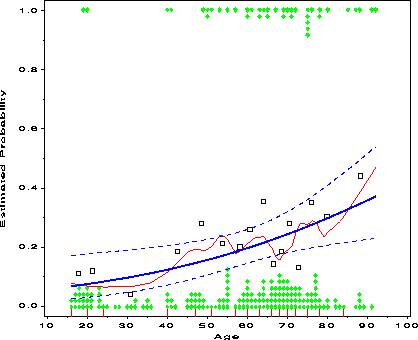Visualizing Categorical Data: logodds
$Version: 1.1 (11 Mar 2001)
Michael Friendly
York University
Plot empirical log-odds for logistic regression
For a binary response variable, Y, taking values 0 or 1, and a continuous
independent variable, X, the LOGODDS macro groups the X variable into some
number of ordered, non-overlapping intervals. It plots the empirical
log-odds of Y=1 (and/or Pr{Y=1}) against X for each interval of X, together with the fitted linear
logistic relation, an optional smoothed curve (using the LOWESS macro), and
the observed binary responses.
The input data to be plotted must be in case form. The LOGODDS macro is
called with keyword parameters. The X= and Y=
variables are required. The arguments may be listed within parentheses in
any order, separated by commas. For example:
%logodds(data=icu, x=age, y=died);
- X=
-
Name of the continuous independent variable
- Y=
-
Name of the binary response variable
- EVENT=
-
Value of Y for the event of interest [Default:
EVENT=1]
- DATA=
-
The name of the input data set [Default:
DATA=_LAST_]
- OPTIONS=
-
Options for PROC LOGISTIC, for example,
OPTIONS=DESCENDING.
- NCAT=
-
Number of categories of the X variable. For example, if deciles of X are
desired, use
NCAT=10. [Default: NCAT=10]
- PLOT=
-
Scale(s) for the response. PLOT=LOGIT gives a plot on the logit scale, PLOT=PROB on the probability scale. [Default: PLOT=LOGIT PROB]
- SMOOTH=
-
Smoothing parameter for a lowess smooth, in the interval (0-1). No smooth
curve is produced unless a SMOOTH=
value is specified.
- SHOW=
-
Specifies whether to plot the binary observations. [Default:
SHOW=OBS]
- OBS=
-
Specifies how to display the binary observations. If
OBS=STACK, the observations are plotted in vertical columns at the top (Y=1) or bottom (Y=0) of the plot. If OBS=JITTER a small random quantity is added (Y=0) or subtracted (Y=1) to the Y value. [Default: OBS=STACK]
- NAME=
-
The name of the graph in the graphic catalog [Default:
NAME=LOGODDS]
- GOUT=
-
The name of the graphic catalog [Default:
GOUT=GSEG]
Example
%include catdata(icu);
%logodds(data=icu, x=age, y=died, smooth=0.25, ncat=16,
options=order=data);

See also
inflogis Influence plot for logistic regression models
powerlog Power for logistic regression, quantitative predictor
![[Previous]](../icons/previous.gif)
![[Next]](../icons/next.gif)
![[Up]](../icons/up.gif)
![[Contents]](../icons/contents.gif)
![[Search]](../icons/search.gif)
Previous: lags Next: mosaic Up: Appendix A Top: index.html
